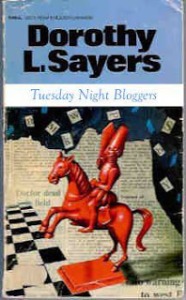 Last week for the Tuesday Night Bloggers, I wrote a piece on Gaudy Night, which I envisaged being quite controversial but in fact it turned out a lot of people loved Gaudy Night as well. This week I am only maybe being slightly less controversial by suggesting 5 Sayers novels to try and only 1 to avoid and I imagine many readers will have very different opinions to myself. But it is always great to hear other people’s opinions and I hope it give some ideas to the Sayer novice. I do like more than 5 of her novels, but considering the relatively small oeuvre of her work (in comparison to Marsh and Christie), I didn’t want to end up recommending the majority of her work, as that would somewhat defeat the purpose of the list. In my choice of recommendations I have tried to give suggestions from different stages of her career, in order to give readers a well-rounded impression of her work. If you think a different novel or two should have been in the list instead, let me know in the comments section below.
Last week for the Tuesday Night Bloggers, I wrote a piece on Gaudy Night, which I envisaged being quite controversial but in fact it turned out a lot of people loved Gaudy Night as well. This week I am only maybe being slightly less controversial by suggesting 5 Sayers novels to try and only 1 to avoid and I imagine many readers will have very different opinions to myself. But it is always great to hear other people’s opinions and I hope it give some ideas to the Sayer novice. I do like more than 5 of her novels, but considering the relatively small oeuvre of her work (in comparison to Marsh and Christie), I didn’t want to end up recommending the majority of her work, as that would somewhat defeat the purpose of the list. In my choice of recommendations I have tried to give suggestions from different stages of her career, in order to give readers a well-rounded impression of her work. If you think a different novel or two should have been in the list instead, let me know in the comments section below.
1.The Documents in the Case (1930)
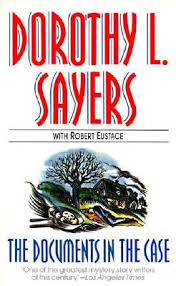
This is one of those rare occasions where Sayers wrote without using her serial sleuth, Lord Peter Wimsey and even more unusual is the fact that the novel consists entirely of documents as opposed to a conventional narrative text, which is one of the main reasons why I enjoyed it. These documents record events prior to and after the murder of Harrison, who seems to have died after eating lethal muscarine. But is it suicide, murder or accident? Martin Edwards in his book The Golden Age of Murder (2015) suggests that this novel was part of a shift in Sayers’ work, moving from a puzzle to character focus and relationships and character dynamics are key to the solving of this mystery. Moreover, Edwards also informs us that this novel was influenced by the Thompson/Bywaters case (1922), a real life case which several of the Detection Club writers were interested in. Another unusual factor about the book is that Sayers co-authored it with Robert Eustace, a scientist who seems to have collaborated with more than one crime writer on a book, providing the necessary scientific know-how.
- Strong Poison (1930) and Have His Carcase (1932)
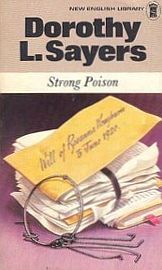
Initially my plan was to only pick one book from the Harriet Vane Quartet and that was to be Have His Carcase, as I think it has the strongest mystery plot out of the four, with Harriet Vane encountering a dead body on the beach, whilst on holiday. Not only is there ample detective work by Vane and Lord Peter Wimsey, but I also liked the progression and changes made in their relationship. However, it is because of this I have included Strong Poison, as I realised that unless you read Strong Poison first, you would lack some of the relationship background, as their initial meeting is a fairly dramatic one to say the least. Part of me always regrets having read them in a jumbled up order when I first read them (Starting with the third, then the second, then the fourth and then first- which wasn’t fatal to my enjoyment but still a bit daft).
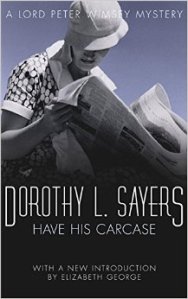
- Murder Must Advertise (1933)

This is definitely one of my favourite non-Harriet Vane, Lord Peter Wimsey novels and it sees Peter working undercover in an advertising firm dealing with both a blackmailing and drug network and a suspicious accidental death. Though the body count doesn’t stay that low for long. Sayers herself, prior to her writing career, worked in an advertising agency and I think this is evident in the way she can vividly recreate it on the page and isn’t afraid to poke fun at it and the mores of writing advertising slogans. I found this novel to have an engaging mystery which was set in an entertaining milieu and when I do get round to re-reading Sayers this will be high on the list. Daringly I also suggest this might be a good book for Sayer novices to start with. I would be interested to see what fellow Sayers readers make of this, as I know at least one fellow blogger who can’t stand the book due to the dialogue style.
- The Unpleasantness at the Bellona Club (1928)
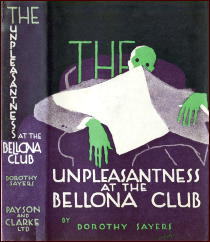
Going back a little earlier into Sayers’ work, I think this book has another strong mystery at its centre with Lord Peter Wimsey investigating the death of General Fentiman which has many unusual features and more importantly the time of his death greatly affects his heirs’ inheritance. Witnesses either fleeing or lying, pose some challenges to Peter’s investigation. Contributing to the zeitgeist of the time period, this novel also engages with WW1 and its consequences, with male characters for example expressing their disillusionment and suffering, and Martin Edwards also suggests that Sayers ‘gained a first-hand insight into the nightmarish world of the trenches (Edwards, 2015: 193) through her husband Mac who suffered as a consequence of his WW1 experiences.
- Clouds of Witnesses (1926)
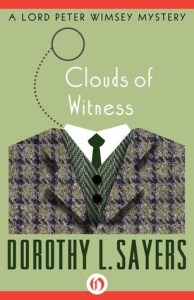
This is the earliest book on my suggestions list, being the second one Sayers wrote, whilst dealing with one of the most painful episodes of her life. At this time, she had managed to take time off from work and stay away from her family whilst she secretly gave birth to a child. And family is definitely the focus of Cloud of Witnesses as murder occurs at Lord Peter’s Wimsey family home, currently owned by his older brother, The Duke of Denver. Even the victim is Peter’s sister’s fiancée. Arguably one of Peter’s hardest cases logistically and emotionally (though he laughs this off in Gaudy Night), as his brother is put on trial for the murder. I think the family drama which ensues through this mystery is what drew me to this novel when compiling this list, as it gives the mystery a tense and dramatic atmosphere and also in a way forces Wimsey to not detect in such a detached way.
Special Mention: The Wimsey Papers (1939-1940)
At the beginning of WW2, Sayers wrote pieces for The Spectator purporting to be letters and diary extracts from her characters, who are describing their reactions to contemporary events such as black outs and enlisting. Helen Denver, Peter’s sister in law never popular in the books, works in the Ministry of Instruction and Morale (a poorly hidden reference to the Minister of Information) and this becomes a consistent area of satire. The characters are not just mouth pieces for Sayers, as they remain within character throughout. There is no mystery element or plot to these pieces, but for the Sayers reader who thought they had read everything, they might be of some interest and amusement, as the Dowager is on top form.
And now for the one to avoid…
The Nine Tailors (1934)
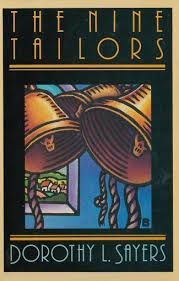
Out of all Sayers novels this is definitely one I am unlikely to ever re-read and I imagine if any new reader to Sayers ever read this book, they might understandably never try her works again. So if you are a new reader to Sayers stay well away. Why? Well there is nothing wrong with the initial mystery which involves a corpse in a grave it shouldn’t be in, but the main gripe I think most people have with the book is the excessive amount of detail on bell ringing, which kills the narrative somewhat. Moreover, I think the solution is also a disappointing and possibly implausible one and I don’t think this novel shows Sayers at her best.
One more thing….
Always keen to try new things on my blog I decided it would be fun to do a poll within this post, where you can vote for your favourite Sayers novel. Being a contentious author amongst Golden Age detective fans I am interested to see what the results will be. So have your say and vote now!
Ha! I really liked The Nine Tailors, back in the day. The one I’d recommend people avoid id Whose Body?
LikeLiked by 1 person
Why did you like The Nine Tailors? and what was so awful about Whose Body?
LikeLike
I was nodding away at nearly all of this – but would just have to swap Documents (for me, dull) for Nine Tailors (love it). I am now torn deciding which of Tailors and Advertise is my favourite. I would totally agree that Advertise would be the perfect starter for someone looking to investigate Wimsey. I just love the picture of office/home life of the era, even if I would contend that the drug distribution scheme is beyond ridiculous!
LikeLiked by 1 person
I think the playing around with language and words made MMA a good book for me and I am glad someone agrees that it is a good book to start with. So did you quite enjoy the info about bell ringing or was there another aspect you loved about The Nine Tailors?
LikeLike
I gave up on Sayers after reading one of her short stories which involved identical twins. I always thought identical twins were a big NO in golden age mystery fiction, so I was shocked because Sayers didn’t even do anything inventive or interesting with the concept, she just used the worst cliché imaginable, which is just lazy, incredibly lazy and arrogant, I have very little respect for an author who thinks her readers are this stupid.
Regarding The Nine Tailors, I think many people would call that one her masterpiece. I really liked the beginning of the novel, but for me the plot lost its momentum when it jumped forward in time. There you have this really great set-up: a snowed-in little village, a contained location you could use to your advantage, but instead of letting the story play out over one night, or maybe one or two days you drag it out over months. Wimsey leaves and then later he comes back and it all gets really complicated. It might all be awfully clever, although I must admit I didn’t even understand all that stuff about the bells. I might have to reread this one after getting a degree in classical music.
LikeLiked by 1 person
Yes the twin solution is a little disappointing but I wouldn’t say one short story is indicative of Sayers’ work as a whole and on the whole I think Sayers was more comfortable and suited to writing in novel format as opposed to the short story.
LikeLiked by 1 person
Well, I’ve read several of her other short stories with “In the Teeth of the evidence” being the only which somehow stuck in my memory.
From the novels othe than “Nine Tailors” I’ve only read “Clouds Of Witnesses” which in German translation was even called “Lord Peters schwerster Fall” (Lord Peter’s Hardest Case) although I’m afraid I can’t recall any specifics. I only remember how Wimsey and Bunter were stumbling through the moor. The murder itself and the solution to it escapes me entirely.
LikeLiked by 1 person
You mean “The Image in the Mirror”? I thought it was brilliant – eerie, with echoes of Hoffmann. The rules, incidentally, don’t forbid twins, but they must be duly prepared for!
LikeLiked by 3 people
It’s not the most memorable Sayers, and the solution is one I find an anticlimax. Still, it has some good comical and character scenes – including Murbles’ anecdote of the miser.
LikeLiked by 1 person
No I can’t say Sayers short stories stick in my mind either and the German title for Clouds of Witnesses is interesting as it does pick up on the emotional difficulties of the case for Peter.
LikeLike
Sayers’ short stories are for the most part, not up to her novel writing, but they were bringing in a living at the time and she was often under pressure to produce them whilst working on longer projects, both at work and writing her novels. I will forgive her the twins! That being said, there are some gems like “The Learned Adventure of the Dragon’s Head” or say, “The Fascinating Problem of Uncle Meleager’s Will”.
LikeLiked by 1 person
The Sayers short story that sticks in my mind is “The Vindictive Story of the Footsteps that Ran.” At the time I first read it, I thought the solution quite clever. That was early days in my mystery-reading career. I still think it one of her best.
LikeLiked by 2 people
Nine Tailors lost its momentum for me when the first 40-odd pages are about bell-ringing and no crime in what we’re sold as a crime novel. I have no problem with context, but this is the kind of egregious info-dumping that people smugly chastise Dan Brown for writ large. Sayers’ contemporaries manages to work in effective atmospheres and background without giving over the entire book to something – see Ellery Queen, Anthony Boucher, John Dickson Carr, Edmund Crispin, even Gladys Mitchell for pity’s sake – and I’ve not quite reached an understanding as to why Sayers is granted so much leeway.
Ah, well.
LikeLiked by 1 person
Nine Tailors… it took me three goes to read it; I was put off by the bell ringing, maths and Bunter shaving his master. I really enjoyed it when I did read it; the flood scenes are impressive and the method is original. I read it again two years ago, but didn’t enjoy it. I was allergic to murder at the time, though.
I’d agree with Murder Must Advertise, and would substitute Unnatural Death for Bellona Club and Clouds of Witness. Tossing up between the Lord Peter stories (many of which are brilliant) and Five Red Herrings, which is the only entertaining railway timetables mystery.
LikeLiked by 2 people
I did toy with putting Unnatural Death into my list but opted for Clouds of Witnesses instead. Can’t quite remember my justification for doing so, perhaps it was just a case of whimsy…
LikeLike
I’m afraid i’d reverse the positions of “Nine Tailors” and “Documents.” Documents nearly put me to sleep when I read it, and I have no interest in re-reading it, which, if you know me, is fairly rare on my part. The documents simply don’t hold my interest and attention. “Tailors,” on the other hand, remains my favorite Sayers novel. I think her writing – especially when writing about that first great peal of the bells – is wonderful. The bells really are presented as if they were different living characters in the book, with their own particular traits and voices – and I think you’ll agree that they should indeed be considered as active characters in terms of the plot. What I’ll call here “the murder method” is pretty much unique in mysteries, as far as I can tell. I do agree with you about “Murder Must Advertise” – a great way to meet Wimsey and to be introduced to Sayers.
LikeLiked by 1 person
I seem to have been quite controversial with my dislike of The Nine Tailors and enjoyment of Documents in the Case. Though seems my suggestion of starting with Murder Must Advertise was not so radical after all. One of these days I may well have to re-read The Nine Tailors and see if my opinion has changed.
LikeLiked by 1 person
Well I don’t want to add to the general mayhem that seems to have ensued your article 😉 but, my favorites among the ten I have read …Murder Must Advertise and The Nine Taylors.
LikeLiked by 1 person
haha more mayhem the better I say…
LikeLike
Really didn’t care for The Five Red Herrings! Much too much speculation, and timetables. I would call this one my vote for book to avoid.
LikeLiked by 1 person
The Five Red Herrings is definitely one of her most puzzle focused ones, which means the narrative style isn’t as strong as some of her other work.
LikeLike
My favorite Sayers is (depending on when you ask me) Strong Poison or Murder Must Advertise. I like SP for the beginnings of the Wimsey/Vane relationship and the beginnings of Sayers “humanizing” him. I just generally love the whole atmosphere of Wimsey’s employment at Pim’s in MMA. I don’t really have a least favorite–but I do have portions that I don’t care for as much–such as the timetables and dialect in Five Red Herrings and the overly-involved dissertation on breaking the code in Have His Carcase. The bell-ringing bits never bothered me much in Tailors, though.
LikeLiked by 1 person
Yes Strong Poison is also an enjoyable novel and glad to have found another fan of Murder Must Advertise. Conversely I don’t think the code breaking in HHC bothered me as much as the bell ringing in NT.
LikeLike
I have only just embarked on my first ever Sayers (yes I know, it’s heretical for someone who claims to be a crime fiction fan)…it’s one of your favourites…Murder Must Advertise…am afraid I don’t see the charm yet but I will persevere.
Is there some particular reason you can sum up quickly that Sayers is considered controversial? (I ask for speed to save you time in writing not me in reading as I am genuinely curious) So much I don’t know…
LikeLiked by 1 person
I think her controversial-ness concerns the fact that she was one of the queens of crime and she tries to elevate the detective novel beyond being just a puzzle and combining it with the novel of manners. She was big in the detection club and did a lot of reviewing in the genre. The results or rather her books are for me really good, I very easily get lost into the worlds she creates. On the other hand, there are readers who don’t like the novel of manner/detective fiction fusion and think she over pads her novels (not entirely fair statement). There is also the charge of snobbery, but that is rather a weak one in my opinion. The texts which are most controversial in her canon are The Nine Tailors (which has some very detailed info on campanology) and the Harriet Vane/LPW quartet. The latter is the most controversial as this is where Sayers over the course of four novels tries to work in a romance which is not rushed or forced or imbalanced gender power relations wise. The last two novels in the quartet are very divisive as some argue that the detective side of the stories is undermined and weak, but as a whole I think the four novels are a great achievement. Sorry to hear that Murder Must Advertise is not grabbing your interest. Hope it hasn’t put you off for life…
LikeLiked by 1 person
[…] beginning on my post I just wanted to share the results of last week’s Sayers Poll which asked readers to vote for their favourite Sayers novel. The results were definitely an eye […]
LikeLike
[…] 1933 and many other subjects besides). However I am, naturally, in the minority and commend you to Cross Examining Crime for a more positive and undoubtedly better-informed […]
LikeLike